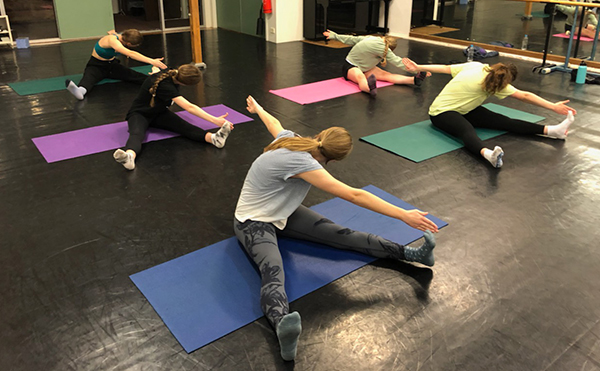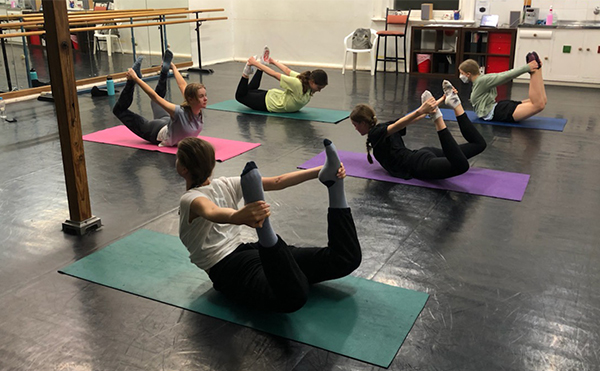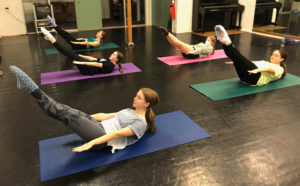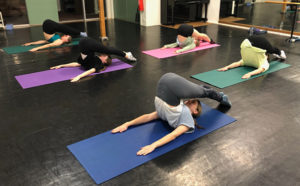
Many moons ago, I began my classical ballet studies in Adelaide. I would go from school, to ballet, to home, to bed and repeat – much like many aspiring young ballet dancers do today. My teacher, Susan Taylor – to whom I am forever grateful – often reiterated the importance of “the three D’s” (Determination Defies Defeat) as she sought to instil in her students the notion that perseverance can indeed lead to great accomplishment.
To help her students along this path (which in the context of ballet requires the dancer to enhance their neural pathways that govern precision of movement and build strong and supple muscles so that technical skill can be developed) “Miss T” ensured that we all, from about age 12 and upwards, participated in “limbering” classes.
These classes were a mix of Pilates exercises, ballet-specific strength exercises and stretches that resembled many well-known yoga asanas (poses). My young brain and body often struggled as it pushed through the required repetitions, sets and long-held stretches that I found to be gruelling (endurance was not my forte).
To further burst my bubble, I would catch a glimpse of the girl next to me who appeared to be effortlessly and perfectly executing everything; she was strong, pliable and blessed with “the ballet body”. Gracefully, she would execute each movement with strength and faultless alignment and then fall into positions that I am yet to emulate. Alas, I worked hard to be like her and, although I soon realised this would not be possible, I put my physical limitations aside and strove to be the best version of myself. Due to my determination and courage, I gained much strength and elasticity for which today I am eternally thankful.
Notwithstanding these conditioning classes were not strictly Pilates, many Pilates principles formed the basis of this training; control, concentration, co-ordination, precision, alignment, balance, breathing and flow were expected from all participants.
In the 1980s, the decade in which I began participating in “limbering” classes, Pilates in Australia was not as diffuse as it is today. There were only a handful of people in Adelaide teaching it; Nicole Vass being one of them. Nicole was our recommended dance physiotherapist at the time and, due to a knee injury, it was with her that I attended my first equipment-based Pilates session. The experience was less than pleasurable as I attempted to wake up muscles that had obviously been dormant for most of their existence thus contributing to a weak VMO, a tight IT band and a painful lateral displacement of my patella. Nicole assisted with my rehabilitation and back to dance training I went.
Fast forward to today: I now teach ballet and Pilates at the very same ballet school where my dance journey began. The school is now owned by Terry Simpson, who also taught me in my younger years whilst working for Susan Taylor prior to purchasing the school.
The students I coach are required to attend various forms of conditioning classes if they wish to sit for their ballet exams and I do my best to educate them about the Pilates method. Fortunately, these teenagers are extremely committed, focused and hard-working. I continue to marvel at their “courage and determination followed by tenacity and resilience” (which is fittingly the school’s motto) notwithstanding the hormonal phase they are experiencing during which their bodies are transitioning into adulthood and their minds are often scrambling to keep up with this metamorphosis. They know how to listen and apply corrections (two skills that I believe also belong in the Pilates principles category) because they know that if they do so their ballet technique will improve – I am blessed and honoured to be working in such an environment.
As a special treat for the girls in my weekly Pilates mat class (and a treat for me too) I created a Pilates questionnaire for them to complete. Its purpose was three-fold: to engage the students in reflection upon their personal experience of Pilates, to enable me to gain insight into their perception of Pilates and to serve as the basis for this article.
When many folk think of Pilates, they envisage adults robed in active-wear attending various types of Pilates classes. Although we would all agree that Pilates is for everybody, not all age groups (or other groups for that matter) are equally represented in broader discussions about their personal Pilates experiences. So, to ‘bridge’ the Pilates gap, it is with pleasure that I present to you these young ballet dancer’s thoughts about Pilates.
N.B. I have not altered the student’s written responses; they are presented as they were originally penned. A glossary of ballet steps is provided at the end of this article.

“What did you know about Pilates prior to engaging in formal Pilates training?
Emily L: Previously I viewed Pilates to be the same as limber classes. I was unsure what the difference between them was. However, I was aware that this class was about stretching and strengthening to aid our ballet technique and mobility.
Georgia Du: Not much, honestly. I thought it was similar to yoga with a lot of focus on breath and flexibility. I assumed that it was something for older women, an opportunity to move their bodies.
Tori M: I actually didn’t have much of an understanding prior to taking the class; I only knew that it would help me with stretching and strengthening.
Did this perception change once you began practising Pilates? If so, how and why?
Emily L: After beginning Pilates I found it to have a lot more structure. Many positions have specific placements to enhance the exercise and make the most out of the class. I also find myself learning about anatomy, all the different bones and muscles, how they work, what they’re for and how to strengthen them.
Georgia Du: I learnt how difficult it is and its benefits on strengthening my body. I experience the challenging and rewarding nature of it and realised that there are truly benefits of this for everybody, whether that be a dancer or a mother.
Tori M: Yes: Through taking part in the class I have learnt that Pilates helps strengthen my whole body as it’s all connected. Prior to the classes I thought it would only focus on one part of the body.
Three things I think about during Pilates classes are:
Mimi W: I think about the different muscles that are working and which ballet exercises they may relate to.
Emily L: Personally, I think about how my body looks from an outside perspective. How is it positioned? Am I long and held in place? Where should my head and eye-line be?
Georgia Du: I focus on my breath and being present in the moment. I also think about how grateful I am for my body and the wonderful things it can do.
My favourite Pilates exercise is …….., because ……..:
Sara B: I like the varying bridging exercises we do such as half and full bridging and single leg bridging…. they strengthen my legs, hamstrings as well as my glutes.
Georgia De: Teaser. It really works my abdominals, back, arms and legs. Basically, everything.
Tori M: Bridges. I like it because I have a natural curve in my back so it allows me to really activate my pelvis. I also feel it’s strengthening my abdominal muscles when doing the one leg (extended) bridge.
Some of the images I use during class are:
Heather F: A pole or centre line for connection (visualised during exercises).
Mimi W: When doing the ‘bridge’ exercise, I imagine people walking over my stomach like a bridge. This allows me to remember to suck my stomach into my back to make it as flat as possible.
Jade P: Squeezing sit-bones together to activate core. Stacking shoulders and hips like rocks during side-lying.
Give one or two examples of how you incorporate some of the Pilates principles into your dance classes and how these help your dance technique:
Tori M: I have found before doing pirouettes, before doing the turn, I think about my breathing right before taking off. I used to hold my breath before the turn which made me tense up and restricted me from finishing the pirouette well.
Sara B: Through Pilates I have learnt how to improve balance by aligning the body and weight correctly and how to stabilise using different muscles.
Jade P: The techniques or principles used in Pilates, especially control and centring, become extremely useful in dance steps such as pirouettes, balancés, relevés, promenades and penchés. They allow me to control my stability and therefore improve the technique of the step.
What are some of the things you have learnt during your Pilates classes that you were previously unaware of?
Heather F: How much the control or awareness of exhalation and inhalation of breaths affect movement.
Jade P: Physical anatomy and what different muscle groups do. How important a focused mind is.
Emily L: I have learnt about the body structure, where muscles are placed, how to strengthen them, how to engage them and what they’re used for. I’ve also learnt the importance of placement of the body, certain changes can make a large difference on the exercise.
How do you feel after Pilates classes and what leads you to feeling this way?
Sara B: I feel relaxed, calm and strong. This is due to taking time to breathe quietly before, effectively paying attention to my exercises and muscles and by taking time to stretch and roll out at the end.
Mimi W: After a Pilates class I feel accomplished as I know that I have worked hard to improve and strengthen. I also feel calm and relaxed after.
Heather F: I feel energised and aware.
How does Pilates benefit you?
Jade P: Pilates has not only greatly improved dance technique but given me strength in day-to-day scenarios in carrying objects and sitting and standing with correct posture.
Georgia Du: Pilates benefits me in so many ways. My physical health improves and I feel stronger and fitter. My mental health also improves in its ability to ground me and put things in perspective.
Heather F: Provides a sense of connection. Allows the movement of the body in new ways. Has allowed me to learn new concepts.
If Pilates was a colour, which colour would you see it as being and why?
Emily L: I’d see it as an aqua or navy blue, I think this may be because of the quiet calming space we have during Pilates, calming music with time for us to focus on our bodies. Quiet spaces like this are often related to the sky or the ocean which is why I view Pilates as aqua and navy blue.
Tori M: I associate Pilates as being relaxing almost as relaxing as little ripples/waves over a sunset ocean so when I think about Pilates I think of a pastel orange/yellow like a sunset.
Georgia De: A mix of green of brown to make this dark green. Why? Because Pilates genuinely reminds me of growth. Every lesson I grow just a little bit more in my technique.”
With growth in mind, I would like to thank each of the students for contributing to my growth as a teacher and for sharing their thoughts with us all. It is oftentimes from our students that we learn the most; they contribute to our development as teachers as we strive to find new ways to better assist them and serve them well.
The youth are our future… if we share the Pilates method with them, we can hopefully make the world a better place.
Daniela Di Fabio, PAA Committee Member and Terry Simpson Studios faculty


Pirouette: spinning on one leg with the other leg raised.
Balancé: a travelling waltz-like step.
Relevé: rising, using a snatching action, on to the balls of the feet or on the tippy toes in pointe shoes.
Promenade: turning around or pivoting on one leg (generally slowly) while the other leg is in a raised position.
Penché: a standing position in which one leg is raised behind the body while the dancer bends forward and lifts the raised leg as high as possible.

Comments are closed.